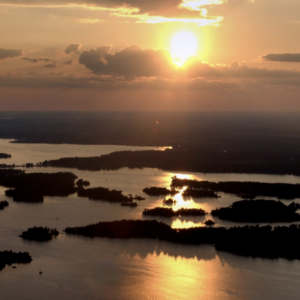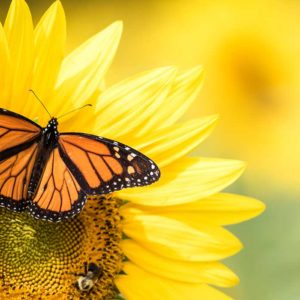Monarchs & Nighthawks – Day 1 of our July NatureBlitz (Part 1 of 3)
During one of the hottest weekends in July, Nature Canada beat the heat with a NatureBlitz held in Ottawa’s Carlington Woods area. The 24-hour event on July 18th & 19th (see the schedule here) was a great success and featured guided walks with local plant and wildlife experts, children’s activities, fun with ultrasonic bat detectors, and a live amphibian demonstration by the Ontario-based group, Save the Salamanders. On behalf of Nature Canada, we would like to thank our volunteers, our experts and the public on coming out!
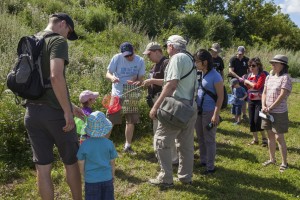
The NatureBlitz featured a number of guided group walks, each exploring a different set of organisms at the site. Photo: Susanne Ure
So what is a NatureBlitz? It’s very much like a BioBlitz, i.e., an effort to inventory as many living things as possible in a given area during a given time, usually 24 hours). However, our NatureBlitz events are more focused on building awareness and educating the public – by helping urban residents explore and experience nearby nature right in their communities. These events are one of the public engagement tools used in our NatureHood program. Like a traditional BioBlitz, our NatureBlitzes take place over 24 hours, include a tally of all the species we observe, and are open to anyone – especially nature-newbies! While we carefully record all of the species we observe throughout the event and during each walk, we also address two important barriers to nature engagement for many people: knowledge and the ‘intimidation factor’. We do this by sharing fun facts, encouraging appropriate hands-on exploration and experiences of nature, and by interpreting the plants, wildlife and local environment for participants. Sound like fun?
We chose Carlington Woods for this summer’s NatureBlitz given its mature trees, the large diversity of birds it is known to host, and the unique ecological setting of the NCC owned property. The entire forest is surrounded by busy streets and dense urban neighborhoods, and that is exactly what piqued our interest. We wondered, can this island of forest hold any species that we would not expect to find within a bustling city?
We’re happy to report that the NatureBlitz showcased just how important isolated pockets of urban forest can be. Not surprisingly they’re safe-havens for wildlife, including species at risk!
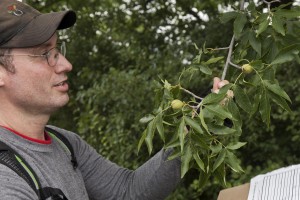
Local plant expert, Owen Clarkin, shows participants the tricks for identifying a Bitternut Hickory during his Trees & Shrubs walk on Saturday. Photo: Susanne Ure
Our first event on the Saturday was a trees & shrubs walk, led by local plant expert, Owen Clarkin. A species of interest was the Butternut tree (Juglans cinerea), which is found peppered throughout this NCC-owned property. Currently, the tree is being attacked by a fungal disease, Butternut canker, and is being wiped out of much of its native range in Ontario, Quebec and New Brunswick. The butternut is a nationally and provincially endangered species, protected by law.
Nature Canada’s own Alex MacDonald hosted two back-to-back events on Saturday: an insect walk and a children’s scavenger hunt. With a large crowd, Alex led visitors out with butterfly nets and temporary sampling containers to catch what they could find. Beetles, butterflies, bees and grasshoppers seemed to be the stars of the walk. After the insect walk, the scavenger hunt attracted even more people, and as a reward, the kids got to exchange their sightings cards for our NatureHood species at risk trading card. The cards highlight 26 local species that are legally protected as special concern, threatened, or endangered, including the Butternut tree and the monarch butterfly – each of which was observed during the walks!
The evening bird walk had some interesting finds. Led again by Alex MacDonald, the group saw (and heard) lots of Grey Catbirds, some Black-crowned Night Herons flying over, and even a Brown Thrasher. The group even spotted a provincially and nationally threatened species: the Common Nighthawk (Chordeiles minor). This nocturnal species’ main food source is flying insects. With the large-scale use of pesticides, and the resulting pollution of downstream waterways where many flying insects breed, coupled again with habitat loss and the perils of migration, there has been a widespread decline in Common Nighthawks across Canada. The species considered at-risk with a “special concern” designation in Ontario.
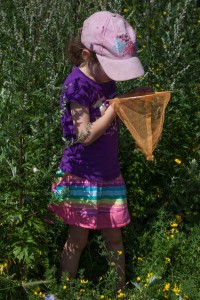
One of our scavenger hunt participants checks to see if there’s a lady beetle in her net. Photo: Susanne Ure
Our bat walk at dusk proved to be quite a popular choice for people, as well! Not only did we hear these amazing flying mammals, we also saw them! Flying overhead and probably catching the mosquitoes trying to bite us, we used an array of handheld bat detectors to ‘hear’ the ultrasonic echolocation signals – similar to sonar – of the bats at frequencies audible to human ears. By tuning the detectors to different frequencies and listening to changes in the quality of the sound, it’s possible (with practice!) to get a sense of which species may be flying overhead. The species we detected included the Big Brown Bat (Eptesicus fuscus; confirmed visually) and either the endangered Little Brown Bat (Myotis lucifugus) or the Tri-coloured Bat/Eastern Pipestrelle (Perimyotis subflavus). It’s a case of ‘either, or’ because those two species echolocate at roughly the same frequencies, both can have light undersides (which we observed) and the habitat at Carlington Woods is suitable for both. We’re conducting follow-up assessments in the area and reviewing our audio recordings from the night to reach a conclusion on the latter two.
Take a listen to what bat echolocation sounds like within our hearing range below!
Pssst! Nature Canada now offers a FREE public bat detector lending library for anyone in the National Capital Region interested in borrowing one! Contact us here to inquire.
A big thanks to Nicolas Conroy, Nature Canada’s NatureHood Conservation Intern, who prepared a draft of this post!
To be continued…
Financial assistance for this project has been provided by:



